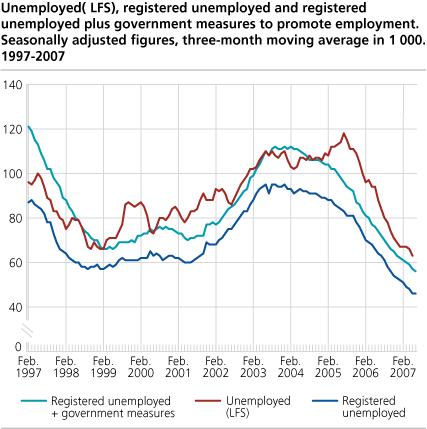Content
Published:
This is an archived release.
More people work full time
From the second quarter of 2006 to the second quarter of 2007, the number of people in full-time employment increased by 71 000 according to the Labour Force Survey (LFS). The increase was evenly distributed between men and women.
Seasonally adjusted figures: growth in employment continues
Adjusted for seasonal variations, there was an increase in employment from the first quarter of 2007 to the second quarter of 2007, while the unemployment rate remained stable.
Adjustments for seasonal variations allow for the analysis of current developments in the labour market, and serve as an alternative to comparisons with the corresponding quarter in the previous year. Seasonally adjusted figures are presented in a separate article .
From the second quarter of 2006 to the second quarter of 2007, employment rose by 80 000 divided between 71 000 in full-time employment and 9 000 in part-time employment. Part-time employment rose by 1.4 per cent in the same period. Average settled working hours were 34.3 hours per week, compared with 34.4 hours per week in the second quarter of 2006. Average settled weekly working hours for men was 37.4 hours and 30.7 hours for women.
Higher labour force participation among the elderly
The labour force (total of employed and unemployed persons) increased by 51 000 from the second quarter of 2006 to the second quarter of 2007, while the working-age population (aged 16-74) rose by 45 000. The proportion of people aged 55-66 years in the labour force increased from 63.4 to 65.5 per cent, mainly caused by an increase in female occupational activity by 3.8 percentage points, or 14 000. The main part of this increase consisted of women who had not previously been in the labour force.Labour force participation also increased in the 67-74 age group. In total, the labour force participation rate rose by 0.8 percentage points for women and 0.3 percentage points for men.
Strongest growth in education
The growth in employment was strongest in education, up 10.4 per cent, or 20 000 people. Public administration, defence and compulsory social security also saw employment increase by 13 000 more people, while the increase in construction was 14 000. This corresponds to an increase of 9.4 and 8.5 per cent respectively. The employment growth in financial intermediation and other business activities continued.
Number of employees on temporary contracts unchanged
216 000 employees were on temporary employment contracts in the second quarter of 2007. This is more or less unchanged from the second quarter of 2006. The education sector and hotels and restaurants had the highest share of temporary contracts, at 15.7 and 15.3 per cent respectively. In health and social work, 14.4 per cent were on temporary contracts. In comparison, the manufacturing (5.4 per cent) and transport and communication (5.5 per cent) had the lowest share of temporary employees.
Unemployment fell by 30 000
According to the LFS, the number of unemployed fell by 30 000 from the second quarter of 2006 to the second quarter of 2007. The decline mainly took place in the age group 25-54 years, were unemployment fell by 20 000. The unemployment rate stood at 2.7 per cent, the male unemployment rate was 2.8 per cent and the female rate was 2.7 per cent. The number of registered unemployed with the Labour and Welfare Organisation showed a decline of 18 000 over the same period.
The proportion of long-term unemployed, defined as persons who have been unemployed for at least six consecutive months, was 22 per cent in the second quarter of 2007, down 9 percentage points from the second quarter of 2006. The majority of the decline in long-term unemployment was among people who had been unemployed for more than a year.
Number of underemployed unchanged
Underemployment is defined as employees with part-time as settled working hours who want to work more hours. The number of underemployed was 109 000 in the second quarter of 2007, about the same level as in the second quarter of 2006. In the second quarter of 2007, the underemployed represented 17 per cent of all part-time employees.
When accounting for the fact that many unemployed and most underemployed are looking for less than full-time work, these two groups together wanted work equivalent to a total of 98 000 full-time positions in the second quarter of 2007, 26 000 less than in the second quarter of 2006.
(1) The figures for underemployment in 2006 and 2007 are incorrect. More information is available here .
Tables:
- Table 1. Population aged 15-74(1) in the labour force, man-weeks worked, unemployed (LFS)(2), registered unemployed persons and persons employed by government measures (Aetat). 1000 and per cent
- Table 2. Population aged 15-74(1) år in the labour force, employed persons and unemployed persons by sex (LFS)(2). 1000 and per cent
- Table 3. Persons in the labour force and employed persons aged 15-74 and sex (LFS). 1 000 and per cent
- Table 4. Population aged 15-74, employed persons by contractual/usual working hours per week(1) and unemployed persons by age and sex (LFS). 1000
- Table 5. Persons in the labour force aged 15-74 by age and sex. 1000 and as per cent of all in each group
- Table 6. Employed persons aged 15-74 by sex and contractual/usual working hours pr week (LFS). 1 000
- Table 7. Population aged 15-74 by main activity, part-time employment1 and age (LFS). 1 000
- Table 8. Employed persons aged 15-74 by major industry division (LFS). 1000
- Table 9. Number of man-hours worked per week1, by industry division (LFS). 1 000
- Table 10. Employed persons aged 15-74, total, and employed persons at work by status and sex. Number of man-weeks worked1 and actual working hours per week (LFS)
- Table 11. Employed persons aged 15-74 and absence from work(1) during the whole reference week by reason for absence and sex (LFS). 1000 and per cent
- Table 12. Employees aged 15-74 with temporary jobs, by major industry division (LFS). 1000 and as per cent of all employees
- Table 13. Unemployed persons aged 15-74 by sex and age (LFS). 1000 and per cent
- Table 14. Unemployed persons aged 15-74 by duration of job search (LFS). 1000 and per cent
- Table 15. Unemployed persons aged 15-74 by main activity (LFS). 1 000
- Table 16. Unemployed and underemployed persons aged 15-74, by sex and desired working hours per week. Number of man-weeks (of 37,5 hours) supplied (LFS). 1000
- Table 18. Persons in the labour force aged 15-741 by sex and region (LFS)2. 1 000 and in per cent of total
- Table 19. Employed persons aged 15-74 by sex and region (LFS). 1 000
- Table 20. Employed persons aged 15-74 by sex and regions (LFS) as per cent of all inn each group
- Table 21. Employed persons aged 15-74 by some major industry division and region (LFS). 1997-2006 . 1 000
Contact
-
Arbeidsmarked og lønn
E-mail: arbeidsmarked@ssb.no
-
Erik Herstad Horgen
E-mail: erik.horgen@ssb.no
tel.: (+47) 93 08 68 62
-
Håvard Hungnes Lien
E-mail: havard.lien@ssb.no
tel.: (+47) 40 90 26 06


